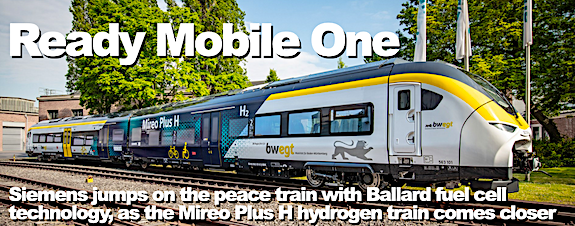Ready Mobile One: Siemens jumps on the peace train with Ballard fuel cell technology

The latest news from Germany concerns a technology that just can’t get enough attention, that’s the Siemens Mobility’s Mireo Plus H passenger trains.
Ballard Power Systems picked up an order for 14 x 200 kW fuel cell modules from Siemens to power a fleet of seven Mireo Plus H passenger trains. Delivery of the 14 fuel cell modules is expected to start in 2023 with the fleet planned to be in service in Berlin-Brandenburg region in late 2024. It’s a decisive step away from diesel-electric rail that has dominated the field for decades.
In addition to the initial order of 14 fuel cell modules, Siemens Mobility also signed a letter of intent with Ballard for the supply of 200 fuel cell modules totaling 40 MW over the next six years, including a firm commitment on 100 of the fuel cell modules totaling 20MW.
It’s a collaboration that goes back to 2018 — a new generation of fuels cells with the lifecycle and power density required for the Mireo Plus H project. RWTH Aachen University was a partner in the research project. The German Federal Ministry for Transportation and Digital Infrastructure (BMVI) will support Siemens and RWTH Aachen with project funding of roughly €12 million as part of the Ministry’s “National Hydrogen and Fuel Cell Technology Innovation Program”. The program was coordinated by the National Organization for Hydrogen and Fuel Cell Technology.
The top line data
As a two-car train, the Mireo Plus H has a range of up to 800 kilometers. The hydrogen train is as powerful as electric multiple units. It features a high traction power of 1.7 MW for up to 1.1 m/s² acceleration and a maximum speed of up to 160 km/h. The three-car version of the train has a range of 1,000 kilometers.
Yes, not every route is electrified
What makes the Mireo Plus H pretty special? It has to do with non-electrified lines, when you have to carry the power — and you need power. The math with carrying meaningful amounts of battery electricity is tough. Yet, Europe’s had a long look this year at the price paid for depending on, say, Russian oil and gas supplies, and had a long hot summer to think about the price on inaction on climate change. How do you jump on the peace train and still have a working solution for passenger transit.
Two Siemens engineers summed it up well.
As Nikolaos Papaiordanidis observed: As one of the employees responsible, I naturally see it as having a tremendous role. Our main focus has been on enabling it to meet the current challenges in regional transport on non-electrified routes while anticipating future developments that we can already predict. These primarily involve carbon-neutral mobility. But it’s also much more than that, including classics like low lifecycle costs and high vehicle performance, which enable customers to reduce the intervals between trains or design timetables where the vehicles can be decoupled or routes extended. The regional trains of the future must be able to take advantage of these solutions, in what will have to be a modularly combinable form if they’re to optimally benefit the environment, operators, and passengers. This is exactly what’s behind the Mireo Plus H platform concept, and operation of the prototype will provide us with important insights into how we can best support the various goals of our customers.
His colleague Peter Eckert continued: Let’s take the issue of operating range, which is as applicable to rail as it is to road. As soon as you have to carry traction power on board, you have a limited operating range that depends on the capacity of the tank that can be installed as well as on the weight and size of the batteries. Optimizing the system to achieve the longest possible operating range requires a skillful interaction between the hydrogen and battery systems. But what is usually forgotten is the effect of the basic vehicle on this design and optimization. The Mireo family has been fundamentally redesigned as a two-car and three-car trainset with a view to saving energy – from its many lightweight car shell components to its improved aerodynamics and newly developed traction kit. Based on this energy-saving, modular platform, we’ve optimized a battery-powered train (Mireo Plus B) for up to 120 km distance, and Mireo Plus H as a hydrogen-powered train for ranges of up to 1,000 km – depending, of course, on the mode of operation and line topology.
The Siemens backstory
The backstory and a whole bunch of videos and backgrounders are here.
The Siemens – Ballard backstory is here
Yep, they’ve been at this for four long years, read all about it here.
Reaction from the stakeholders
“This is a significant milestone for our multi-year collaboration efforts with Siemens Mobility and the future of zero-emission commuter rail in Europe. Our fuel cell technology is an ideal solution to support the heavy payload, long range and rapid refueling requirements of Siemens Mobility’s passenger train fleet. We look forward to our continued collaboration and are excited for the opportunity to support the Berlin and Brandenburg region’s first hydrogen powered rail network,” said David Mucciacciaro, Ballard Chief Commercial Officer. “We will continue our work to secure platform wins with key partners in our core verticals and to support their scaling plans to achieve decarbonization.”
“We can only meet climate change targets by increasing rail transportation. Our first order for a fleet of hydrogen-powered trains will enable emission-free rail transport on non-electrified routes in Germany,” said Jochen Steinbauer, Platform Director H2 Technologies at Siemens Mobility. “Our Mireo Plus H is a next-generation hydrogen train, featuring longer range, faster acceleration and state-of-the-art technologies, setting new standards in zero-emission passenger transport.”
Category: Top Stories















